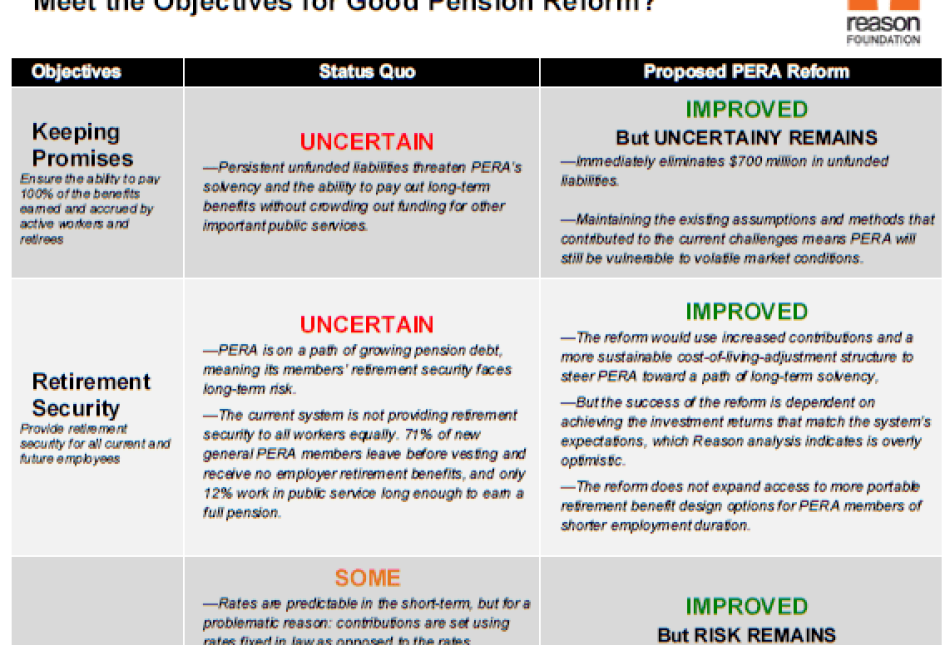Stars have aligned for needed pension reform

The following appeared in the Santa Fe New Mexican on Saturday, January 25, 2020.

Over the last few weeks leading up to the 2020 legislative session, an all too rare alignment has occurred in New Mexico—the Governor, legislators from both parties, labor and taxpayer representatives, plan managers and other stakeholders in Santa Fe all agree that it is time to reform the state’s largest public pension system.
New Mexico’s Public Employees Retirement Association (PERA) has amassed over $6 billion in unfunded pension liabilities and has become vulnerable to volatile investment markets. The Governor’s PERA Solvency Task Force recognized the growing unfunded liability problem and acknowledged the need to fully pay for state promises by making PERA a fully funded system within 25 years a top priority. The resulting task force recommendations mainly increase contributions and address a broken cost-of-living-adjustment policy that served more as annual pension bonuses than it did a protection against inflation.
The proposed reforms are a great first step towards addressing the debt currently looming over the state budget. However, there remains more work to do, as the current legislation would do little to address the systemic assumptions and policies that led to debt accumulating in the first place, mainly a lack of protections against market volatility, overly optimistic actuarial assumptions, and letting the political process—not actuarial math—determine annual pension contribution rates.
Consider that while passing the proposed legislation would generate a one-time reduction in unfunded liabilities by an estimated $700 million, in fiscal year 2019 alone the unfunded liability increased by $600 million due mostly to underperforming investments and insufficient contributions.
While the legislature continues to reject plan actuary recommendations and rely on bureaucratic statutes to determine its contribution to PERA, assets will continue to depend on high market returns to make up for subtle dips and losses. The debt is also still likely to grow due to PERA maintaining market assumptions that even PERA forecast only give a 60% chance of coming to fruition. Some more long-term market forecast view PERA’s chances at less than 50/50.
If there’s a future where market returns may not be as rosy in the past, we need to plan for it now by saving more and adopting more conservative assumptions. Otherwise, PERA will continue to accrue unfunded liabilities to be borne by tomorrow’s taxpayers and public employees since both are ultimately responsible for making the contributions needed to ensure that accrued benefits are fully paid to retirees. If contributions are not increased today, even higher increases will be required tomorrow.
It’s no wonder why public employers are struggling to attract top talent away from the private sector. New Mexico promises retirement benefits at the end of a full career then neglects to fund those benefits at adequate levels to where unfunded liabilities grow. This trend can produce rising debt payments and stagnant wages as limited state budget resources are reallocated to meet immediate needs.
The proposed reform aims to prevent that dynamic from persisting, or at least start the process. As important of a first step towards shoring up PERA’s long-term solvency the proposal is, to avoid growing state pension debt in the future will require both PERA and Educational Retirement Board (ERB) stakeholders to work towards adopting more conservative actuarial assumptions, pay down pension debt faster, and create attractive retirement plans for what is likely to be an increasingly professionally-mobile future workforce.
Reforming a broken cost-of-living-adjustment and increasing contributions are great ways to begin addressing the PERA unfunded liability. The legislature can also harness this rare bi-partisan cooperation to strengthen the task force recommendations by also addressing the systemic risk associated with high investment expectations and statutory contribution policies that will continue to generate unfunded liability unless reformed. The Governor, legislative leaders and numerous stakeholders are all right, the time to reform PERA is now.
Gessing is president of New Mexico’s free market think tank, Rio Grande Foundation and Gilroy is vice president for government reform at Reason Foundation, a think tank focusing on free minds and free markets
